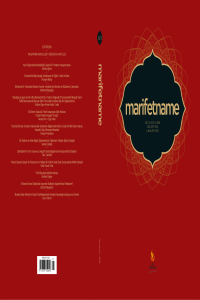Tekirdağlı eş-Şeyh el-Hâc Hâfız Mehmed Rifʿat’ın “Ebhe’n-Neğamât fî Terennümâti’l-İlâhiyyât” İsimli Güfte Mecmuasında Bulunan İlâhî Formundaki Eserlerle İlgili Bir Değerlendirme
Abstract
Güfte mecmûaları, Türk Mûsikîsi tarihinin en önemli kaynaklarındandır. Güfte mecmûaları eserlerin sadece güfteleri hakkında değil, o eserlerin formları, usûlleri, makam ve bestekârları hakkında da bilgi verdiği gibi, Türk mûsikîsi târihi ve kültürü yönüyle derlendikleri ve yazıldıkları dönemin de bir bakıma aynası olma görevini yapar. Bu mecmûalar genel anlamda güfte mecmuaları şeklinde isimlendirilmiş olsa da ihtiva ettiği konuları itibariyle dînî ve dindışı şeklinde ayrıma da tabi tutulmuştur. Zamanla yapılan incelemeler neticesinde ise şiir mecmûası, şarkı mecmûası, ilâhî mecmûası vb. başlıklarla tasnif edilmiştir. Güfte mecmûalarının türlerinden biri olan ilâhî mecmûaları da tertib edildiği dönemdeki tekkelerin mûsikî târihi, edebiyat, sanat ve kültür târihi açısından önemli bilgiler verdiği gibi tekkelerin mûsikîsi ile alakalı eserlerin günümüze ulaşmasını sağlamıştır. Bu çalışmamızda İstanbul Üniversitesi Nadir Eserler Kütüphanesinde TY 4116 no’da kayıtlı Tekirdağlı eş-Şeyh el-Hâc Hâfız Mehmed Rifʿat’ın “Ebhe’n-neğamât fî terennümâti’l-ilâhiyyât” isimli güfte mecmuasında bulunan ilâhî formundaki eserlerin makâm, usul, bestekâr, güftekâr, nota durumu, eserlerde geçen tarikat isimleri ve güftelerin farklı besteleri yönüyle analizleri yapılmıştır.
References
- Aytemur, Begüm. “Müzik Araştırmalarında Nitel Veri Analizi”. Müzik Araştırmalarında Bilimsel Yöntem ve Yaklaşımlar. 233-263. Ankara: Nobel Akademik Yayıncılık, 1. Basım, 2022.
- Devellioğlu, Ferit. Osmanlıca - Türkçe Ansiklopedik Lûgat. İstanbul, 1962.
- Ergen, Aytaç. “Notam 1.0 Nota Arşiv Programı”. İstanbul: 1A Takımı Bilgisayar, ts.
- Ergun, Sadeddin Nüzhet. Türk Musikisi Antolojisi. İstanbul: İstanbul Üniversitesi Yayınları, Rıza Coşkun Matbaası., 1942.
- Korkmaz, Harun. Türk Musiki Tarihinin Kaynağı Olarak Güfte Mecmuaları. İstanbul: İstanbul Üniversitesi, Doktora Tezi, 2021.
- Mehmed Rifʿat, Tekirdağlı eş-Şeyh el-Hâc Hâfız. Ebhe’n-Neğamât fî Terennümâti’l-İlâhiyyât. İstanbul Üniversitesi Nadir Eserler Kütüphanesi, 894.35-1, 786 v. http://nek.istanbul.edu.tr:4444/ekos/TY/nekty04116.pdf Pakalın, Mehmed Zeki. Sicill-i Osmanî Zeyli. Ankara: Türk Tarih Kurumu Yayınları, 2008.
- Sâmi, Şemseddin. Kāmûs-ı Türkî. İstanbul, İkdam Matbaası., 1317.
- Saʿdiyyü’l-Mevlevî, Mehmed Rifʿat. Âyîn-i Şerîf Mecmuası. İstanbul: İstanbul Atatürk Kitaplığı Belediye Yazmaları Koleksiyonu, O 0130.
- Tüysüz, Fatih. Türk Din Musikisi Formlarında İlahi ve TRT Repertuarındaki İlahilerin İncelenmesi. Sivas: Cumhuriyet Üniversitesi, Sosyal Bilimler Enstitüsü, Yüksek Lisans Tezi, 2017.
- Uslu, Recep. “Türk Müziği Eğitim Tarihinde Güfte Mecmuaları ve İnceleme Esasları Üzerine Tespitler”. 158-168. Ankara: T.C. Kültür Bakanlığı, 2001.
- Uzun, Mustafa İsmet. “İlâhi”. Türkiye Diyanet Vakfı İslâm Ansiklopedisi. 22/64-68. İstanbul: TDV Yayınları, 2000.
- Uzun, Mustafa İsmet. “Mecmua”. Türkiye Diyanet Vakfı İslâm Ansiklopedisi. 28/265-268. Ankara: TDV Yayınları, 2003.
- Yücebaş, A. Hilmi. Tekirdağlı Şairler. İstanbul: Cumhuriyet Matbaası, 1939. Edirne Vilayet Salnâmesi. Vilayet Salnâmesi (1310). https://isamveri.org/salname/sayilar.php?sidno=D02471
An Assessment of the Hymn-Form Works in the Lyric Miscellany Named “Abhā al-Naghamāt fī Tarannumāt al-Ilāhīyyāt” by Tekirdağ-Born al-Shaykh al-Hājj Hāfiz Mehmed Rifʿat
Abstract
Lyric miscellanies stand as some of the most significant sources in the history of Turkish music. These collections provide information not only about the lyrics themselves, but also about their form, usūl (rhythmic cycle), makām (mode), and composer. Additionally, they serve as a reflection of the era in which they were compiled and written, encapsulating the history and culture of Turkish music. Despite being generally named lyric miscellanies; these collections have been subcategorized according to their subject matter into religious and non-religious categories. Over time, through various analyses, they have been further thematically divided under titles such as poetry miscellanies, song miscellanies, and hymn miscellanies. Hymn miscellanies, a specific type of lyric miscellany, offer significant insights into the Takyah music history, literature, art, and cultural history of the era in which they were compiled. They have also ensured the survival of musical works related to the Takyahs (Sūfī lodges) to the present day. This study delves into the analysis of the hymn-form works found in the lyric miscellany named “Abhā al-naghamāt fī Tarannumāt al-Ilāhīyyāt” by Tekirdağ-born al-Shaykh al-Hājj Hāfiz Mehmed Rifʿat, which is housed in the Rare Books Library of Istanbul University under the registry number TY 4116. The analyses cover the makām, usūl, composer, lyricist, notation status, tarīqat (Sūfī order) names mentioned in the works, and the various settings of the lyrics.
References
- Aytemur, Begüm. “Müzik Araştırmalarında Nitel Veri Analizi”. Müzik Araştırmalarında Bilimsel Yöntem ve Yaklaşımlar. 233-263. Ankara: Nobel Akademik Yayıncılık, 1. Basım, 2022.
- Devellioğlu, Ferit. Osmanlıca - Türkçe Ansiklopedik Lûgat. İstanbul, 1962.
- Ergen, Aytaç. “Notam 1.0 Nota Arşiv Programı”. İstanbul: 1A Takımı Bilgisayar, ts.
- Ergun, Sadeddin Nüzhet. Türk Musikisi Antolojisi. İstanbul: İstanbul Üniversitesi Yayınları, Rıza Coşkun Matbaası., 1942.
- Korkmaz, Harun. Türk Musiki Tarihinin Kaynağı Olarak Güfte Mecmuaları. İstanbul: İstanbul Üniversitesi, Doktora Tezi, 2021.
- Mehmed Rifʿat, Tekirdağlı eş-Şeyh el-Hâc Hâfız. Ebhe’n-Neğamât fî Terennümâti’l-İlâhiyyât. İstanbul Üniversitesi Nadir Eserler Kütüphanesi, 894.35-1, 786 v. http://nek.istanbul.edu.tr:4444/ekos/TY/nekty04116.pdf Pakalın, Mehmed Zeki. Sicill-i Osmanî Zeyli. Ankara: Türk Tarih Kurumu Yayınları, 2008.
- Sâmi, Şemseddin. Kāmûs-ı Türkî. İstanbul, İkdam Matbaası., 1317.
- Saʿdiyyü’l-Mevlevî, Mehmed Rifʿat. Âyîn-i Şerîf Mecmuası. İstanbul: İstanbul Atatürk Kitaplığı Belediye Yazmaları Koleksiyonu, O 0130.
- Tüysüz, Fatih. Türk Din Musikisi Formlarında İlahi ve TRT Repertuarındaki İlahilerin İncelenmesi. Sivas: Cumhuriyet Üniversitesi, Sosyal Bilimler Enstitüsü, Yüksek Lisans Tezi, 2017.
- Uslu, Recep. “Türk Müziği Eğitim Tarihinde Güfte Mecmuaları ve İnceleme Esasları Üzerine Tespitler”. 158-168. Ankara: T.C. Kültür Bakanlığı, 2001.
- Uzun, Mustafa İsmet. “İlâhi”. Türkiye Diyanet Vakfı İslâm Ansiklopedisi. 22/64-68. İstanbul: TDV Yayınları, 2000.
- Uzun, Mustafa İsmet. “Mecmua”. Türkiye Diyanet Vakfı İslâm Ansiklopedisi. 28/265-268. Ankara: TDV Yayınları, 2003.
- Yücebaş, A. Hilmi. Tekirdağlı Şairler. İstanbul: Cumhuriyet Matbaası, 1939. Edirne Vilayet Salnâmesi. Vilayet Salnâmesi (1310). https://isamveri.org/salname/sayilar.php?sidno=D02471
Details
| Primary Language | Turkish |
|---|---|
| Subjects | Islamic Studies (Other) |
| Journal Section | Makaleler |
| Authors | |
| Publication Date | June 30, 2024 |
| Submission Date | April 23, 2024 |
| Acceptance Date | May 15, 2024 |
| Published in Issue | Year 2024 Volume: 11 Issue: 1 |
Cite
Marifetname is licensed under a Creative Commons Attribution-NonCommercial 4.0 International License (CC BY NC).


